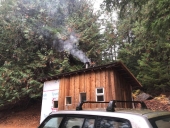
 6
6





 9
9




For all your Montana Masonry Heater parts (also known as) Rocket Mass heater parts.
Visit me at
dragontechrmh.com Once you go brick you will never go back!
 3
3




![Filename: 2024-01-02-19-17-01-Window.jpg
Description: [Thumbnail for 2024-01-02-19-17-01-Window.jpg]](/t/237074/a/230140/2024-01-02-19-17-01-Window.jpg)
 8
8




 3
3




 6
6




carol othdac wrote:thanks for the tips
... make the feed directly at the end of the burn tunnel.....
>> agreed make it straight. Easier to lite. Easier to clean.
...The thin bricks..will get unbearably hot...
I assume you mean at the top horizontal cap. I can do two layers of firebrick there. And continue a bit with them on top end of the 'back' before transitioning to red clay.
>> I think all the thin bricks to the left of your pix will get to hot to touch. Especially the top of the back rest. That is the equivalent of the side of the barrel and the hot gasses are 1000°F at that point. I expect the back rest and the top of the seat will need at least a second if not a third layer of bricks to make them cool enough to sit on. But those will be simple to add after the first burn. A very short fast burn could work as is.
I was wondering how to put in those cleanouts without having sealed doors. I guess most people dont have any cleanouts in J tubes? If not do people use a vaccuum hose at the front burn end? and never get into the bottom of the burn riser to clean I wonder?
"If you always do, what you always did, you'll always get, what you always got!" Mike S.
"It's easy to chop out excess trees. It's really hard to get a mature tree today." Joseph Lofthouse
 1
1





 6
6




 4
4





 6
6




 3
3





 6
6





 2
2




 4
4





 1
1





 2
2








 5
5




 3
3




 2
2




 2
2




 3
3




 2
2




 1
1




 3
3




















 1
1




 4
4




 3
3




 2
2





 2
2




 6
6




![Filename: IMG_20240202_2026078562024-02-02-20_56_38-VID_20240202_202300508.mp4-VLC-media-player.jpg
Description: [Thumbnail for IMG_20240202_2026078562024-02-02-20_56_38-VID_20240202_202300508.mp4-VLC-media-player.jpg]](/t/237074/a/232096/IMG_20240202_2026078562024-02-02-20_56_38-VID_20240202_202300508.mp4-VLC-media-player.jpg)
 1
1





 5
5




 2
2




 2
2




 4
4




carol othdacReborn wrote:Am getting correct rocket draft to the chair seat, but getting back draft, unless I pull the metal seat a bit to create some air (2" ). So the current chimney must be the cause I guess. It's currently 4" dryer vent. Am waiting for 6" to arrive, but in the event that size difference is not the cause, am starting to envision other solutions...
carol othdacReborn wrote:Currently am going out the bottom as per the original design, then it goes up 4 ft and takes another angle out the side wall. I know going through the roof is best, but would like to exhaust all options before I do that..so this is the next idea. Any chance the cause is because the current chimny is exiting at the end/bottom of the seat> and that moving it to the top of the seat would rectify the draw ?
carol othdacReborn wrote:the other idea and is something that can be changed/may have been mistake is the opening from the bell to the seat? I am not seeing that as the issue since it seems I'm getting nice rocket draft past that point. but since that detail was not figured in the original plan, am throwing that out there, as being something to change..see 2nd image.
regards, Peter

|
Is that almond roca? Did you find it in the cat box? What is on this tiny ad?
The new gardening playing cards kickstarter is now live!
https://www.kickstarter.com/projects/paulwheaton/garden-cards
|






